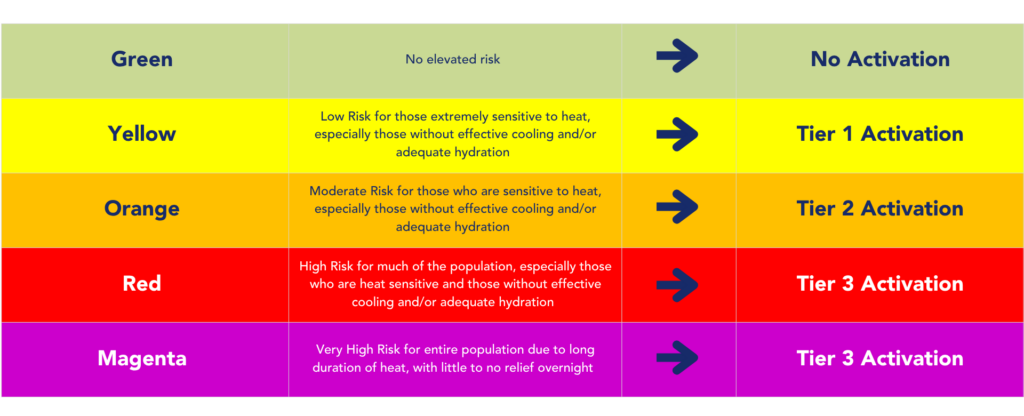Our bodies are dynamic. They adapt over time to the environments we’re in. According to the CDC, it takes about two weeks to fully acclimatize to a hotter environment. As we acclimatize to heat, our bodies become more efficient and effective at cooling down by adapting our heart rate and core temperature, how we sweat, and bringing more of our blood to the skin to allow heat to transfer out of our bodies.
It can also take about a week to lose acclimatization to the heat.
This is why a 60° day may feel warm in March, but cold in August—and an 80° day in May might trigger a Tier 2 severe weather protocols activation, but that same 80° day in August might not cause the same reaction.
This is why we have shifted away from using the Heat Index in the summer of 2023 to using NWS HeatRisk to activate our severe weather protocols for extreme heat. HeatRisk is now the primary driver that NWS uses to issue Heat Watches, Heat Warnings, and Heat Advisories.
The Heat Index, while a useful tool, especially for utilities and infrastructure, only takes into account heat and humidity.
NWS HeatRisk, on the other hand, factors in:
- Local Climatology (Location, Time of Year)
- Forecast (High temperature, low temperature, and duration)
- Impacts (Uses CDC Heat Health Data to identify at-risk groups for any given level of heat)
With all those factors accounted for in NWS HeatRisk, we have a much better tool to forecast not only how hot the region will feel, but how that heat could impact community members within the forecast zone.
When heatwaves hit, older adults (65+), young children, pregnant people, people with chronic health conditions or mental illness, athletes who exercise outdoors, outdoor workers, and people living unsheltered or homeless are most vulnerable. Because many people who are living unsheltered are also older and/or experiencing chronic health conditions (including mental illness), the risk heatwaves pose is significantly heightened. What may seem like “just a summer day” to someone with the shade of a roof, easy access to drinking water and a cool shower, or a change of weather-appropriate clothes, can be life threatening to someone without those basic resources.
Transitioning to using HeatRisk empowers us to respond earlier, when the people who are most likely to experience heat-related harm need support.
This is KCRHA’s third summer using HeatRisk-based activation thresholds. We have aligned our activation tiers for extreme heat to better respond to the actual risk that any given heatwave poses to those living unsheltered in King County.

You can read more about our extreme heat and wildfire smoke activation thresholds here.
Since NWS launched HeatRisk in the Western United States in 2017, many municipalities within King County, including City of Seattle and the county at large, have aligned their heat response efforts to the HeatRisk levels. This allows us to operate in tandem—scaling up (or down) our collective responses together, providing the most resources and services when the most vulnerable among us need them.
We know that housing, not cooling sites and bottled water, solves homelessness. But, until everyone in King County is housed, reacting to heatwaves in a way that prioritizes folks who are most susceptible to the negative impacts of extreme heat can save lives.

